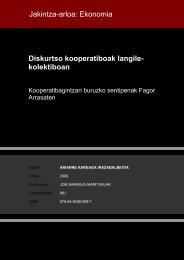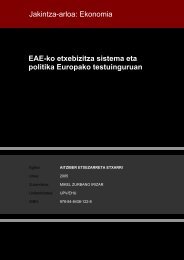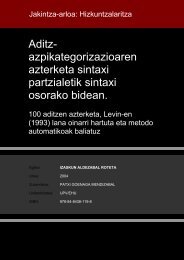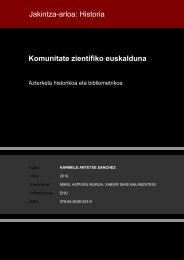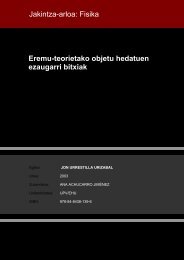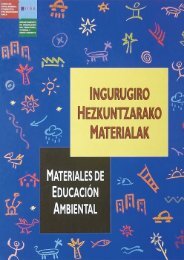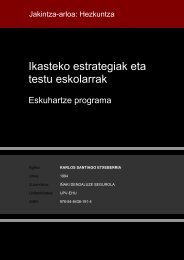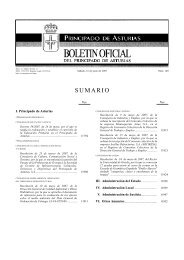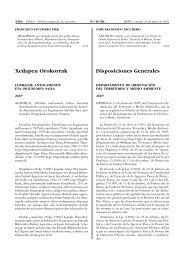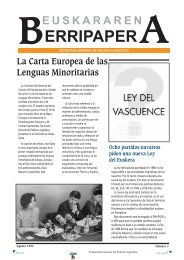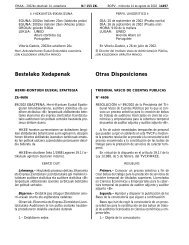- Page 1 and 2:
Jakintza-arloa: Ingeniaritza Sinter
- Page 3 and 4:
Eta hau izan da nire bizitza orain
- Page 6 and 7:
Javiri neuk baino ondiokan poza hau
- Page 8 and 9:
ESKERRAK Lan. hau burutua izan bald
- Page 10 and 11:
"SINTERIZAZIO-ATMOSFERAREN ERAGINA
- Page 12 and 13:
austenita kopurua % 5-ekoa bakarrik
- Page 14 and 15:
AURKIBIDEA 1 . Sarrera . 11 1 .1 Po
- Page 16 and 17:
Taulak . 58 Irudiak . 62 4.Emaitzak
- Page 18 and 19:
Irudiak . 173 6 . Ondorioak . 175 7
- Page 20:
1 . ATALA : SARRERA . CAPÍTULO 1 :
- Page 23 and 24:
1. INTRODUCCIÓN La vía de la pulv
- Page 25 and 26:
Es Europa quien lidera la investiga
- Page 27 and 28:
tabilidad química y resistencia a
- Page 29 and 30:
Las diferencias en el coste de sint
- Page 31 and 32:
de sus propiedades, se ha anticipad
- Page 33:
Por ello, y a fin de comprobar si e
- Page 36:
2 . ATALA : BILDUMA BIBLIOGRAFIKOA
- Page 39 and 40:
2 .1 Constituyentes 2 . RECOPILACI
- Page 41 and 42:
En los dos procesos los hornos se c
- Page 43 and 44:
Debido a la elevada velocidad de so
- Page 45 and 46:
La presencia del hidrógeno hace a
- Page 47 and 48:
asumirse que los aceros rápidos ob
- Page 49 and 50:
Los aceros rápidos de herramientas
- Page 51 and 52:
elementos de aleación para que se
- Page 53 and 54:
nización, para una temperatura det
- Page 55 and 56:
Se introdujeron los factores de int
- Page 57 and 58:
2 .4 .2 .2 Tenacidad en probetas ci
- Page 59 and 60:
plástica, condiciones de L.E .F.M
- Page 61 and 62:
La Fig . 2 .6 /62/ presenta esquem
- Page 63 and 64:
Mientras que Lc en condiciones de f
- Page 65 and 66:
Sin embargo, cuando la grieta encon
- Page 67 and 68:
agrietadas por fatiga, un valor de
- Page 69 and 70:
una LVDT para medir la deflexión e
- Page 71 and 72:
4 .5 GPa, en cambio, ésta disminuy
- Page 73 and 74:
tura corresponden a inclusiones o c
- Page 75 and 76:
en que C es la mitad del espaciado
- Page 77:
donde Ey corresponde a la deformaci
- Page 80:
IRUDIAK FIGURAS
- Page 83 and 84:
C) 925 900 875 850 825 800 775 Q IV
- Page 85 and 86:
as 11 ,IN h, hk I B ----~ a 2 .7 .
- Page 88 and 89:
3 .1 Hautsen karakterizazioa 3 . TE
- Page 90 and 91:
3 .4 Sinterizazioa Sinterizazioak 6
- Page 92 and 93:
lortutako txirbila xehekatu eta gar
- Page 94 and 95:
hartu ziren kontutan : Banadio-, Kr
- Page 96 and 97:
Aq, B q , Cq eta D q ondoko koefizi
- Page 98 and 99:
µ = kontutan hartutako fasearen zu
- Page 100 and 101:
Tratamendu Termikoak sinterizaziora
- Page 102 and 103:
neurtu zen, zein beti agertu zen ma
- Page 104 and 105:
Probeta bakoitzaren haustura-azal b
- Page 106 and 107:
A arrabolen arteko distantzia da, C
- Page 108 and 109:
Hortaz, haustura-erresistentzia, de
- Page 110:
TAULAK TABLAS
- Page 113 and 114:
Materiale Sinterizazio- Atmosfera P
- Page 116:
IRUDIAK FIGURAS
- Page 120 and 121:
0 w 0,050a W= Iamm 9 = i2rrrarr 3 .
- Page 122:
4 . ATALA : EMAITZAK . CAPÍTULO 4
- Page 125 and 126:
4 .1 Sinterización 4 .1 .1 Acero P
- Page 127 and 128:
Metalografía : Las muestras sinter
- Page 129 and 130:
en los MX, probablemente debido a q
- Page 131 and 132:
sinterizaciones de 30°C sin que va
- Page 133 and 134:
La temperatura de aparición de est
- Page 135 and 136:
El proceso de sinterización result
- Page 137 and 138:
con grafito respectivamente, se obs
- Page 139 and 140:
Los MX encontrados en el Px30 son m
- Page 141 and 142:
4 .2 Tratamientos Térmicos 4 .2 .1
- Page 143 and 144:
Se midió el tamaño de grano de la
- Page 145 and 146:
ción . Cada punto es la media arit
- Page 147 and 148:
Mientras que la dureza de temple de
- Page 149 and 150:
Durezas Se midió la dureza a todas
- Page 151 and 152:
4 .3 Ensayos Mecánicos 4 .3 .1 Ens
- Page 153 and 154:
A partir de dichas curvas se calcul
- Page 155 and 156:
ésta, hasta llegar al máximo de d
- Page 157 and 158:
y para más altos contenidos en aus
- Page 159 and 160:
Deflexioaren neurketa makinaren def
- Page 161 and 162:
En el caso del Px30 se estudió no
- Page 163 and 164:
Módulo de Young El módulo de Youn
- Page 165 and 166:
Para durezas altas, las probetas de
- Page 167 and 168:
Transformación de la austenita Par
- Page 169:
superficies de contacto entre part
- Page 172:
TAULAK TABLAS
- Page 175 and 176:
4.1V Taula : Px30 altzairuaren karb
- Page 177 and 178:
4.X Taula : Eutektikoen agerpen-ten
- Page 179 and 180:
4.XIV Taula : Barker saiakuntzen em
- Page 182:
IRUDIAK FIGURAS
- Page 185 and 186:
4 .2 . Ir. : STO- jn sinterizatutak
- Page 187 and 188:
E 70 60 50 40 30 20 10 0 1 0 o ' --
- Page 189 and 190:
8 .5 • O • •o .11 ¡ L] 0 0 E
- Page 191 and 192:
Co H H 70 60 50 40 30 20 10 1 o 1 1
- Page 193 and 194:
4 .14 . Ir . : Hutsean sinterizatut
- Page 195 and 196:
s. .r ~ U C6 • 20 • b 10 • N
- Page 197 and 198:
(o 1000 900 800 700 600 CD Tenplatu
- Page 199 and 200:
a 10 Nm 4 .21 . Ir . : Gasean sinte
- Page 201 and 202:
4 .23 . Ir . : Gasean sinterizatuta
- Page 203 and 204:
L7 A 900 850 800 650 600 550 ' -L 1
- Page 205 and 206:
1000 900 800 700 0 -? AXo}- APERTUR
- Page 207 and 208:
Barker zailtasun-saiakuntza . Ensay
- Page 209 and 210:
4 .37 . Ir . : Lau puntutako makurd
- Page 211 and 212:
N Q) 1 .6 1 .4 1 0 .6 0 - 911 -O ~O
- Page 213 and 214:
Lau puntutako makurdura-saiakuntza
- Page 215 and 216:
Lau puntutan makurdura-saiakuntza .
- Page 217 and 218:
Lau puntutako makurdura-saiakuntza
- Page 220:
5 . ATALA : EZTABAIDA . CAPÍTULO 5
- Page 223 and 224:
5 .1 Densificación 5 .1 .1 Tempera
- Page 225 and 226:
con el mismo o también con que al
- Page 227 and 228:
con lo cual se obtienen los valores
- Page 229 and 230:
donde fvj es la fracción volumétr
- Page 231 and 232:
sido también encontrado en otros a
- Page 233 and 234:
En la figura 5 .4 se han agrupado e
- Page 235 and 236:
mas de sinterizado de los mismos ac
- Page 237 and 238:
dustrial . En dicha tabla se compar
- Page 239 and 240:
Los carburos MC de los aceros estud
- Page 241 and 242:
5 .1 .6 Composición química de lo
- Page 243 and 244:
5 .2 Tratamientos Térmicos En la F
- Page 245 and 246:
También se ha comentado que en el
- Page 247 and 248:
cesos en carbono equivalente y este
- Page 249 and 250:
5 .3 Ensayos Mecánicos 5 .3 .1 Ten
- Page 251 and 252:
derando también los puntos de la b
- Page 253 and 254:
donde se puede estimar el valor de
- Page 255 and 256:
Estos contenidos se calcularon para
- Page 257 and 258:
-mediante la expresión (2 .31)- y
- Page 259 and 260:
do la misma dureza y cantidad de au
- Page 261 and 262:
En la figura 5 .13 se presentan est
- Page 264 and 265:
5 .1 Taula: Karburoetan sartzen den
- Page 266 and 267:
5.1V Taula : MC karburoen konposake
- Page 268 and 269:
5 .VIII Taula : Karbono baliokideak
- Page 270 and 271:
Material Sinterizazio- Atmosfera At
- Page 272:
IRUDIAK FIGURAS
- Page 275 and 276:
Frecuency (%) 100 90 80 70 60 50 40
- Page 277 and 278:
100 80 ó ' 60 .J W H Z 40 w '< 20
- Page 279 and 280:
1 .4 1 0 .8 0 .4 • 1 0 20 Hondar-
- Page 282 and 283:
6 . ONDORIOAK 1 . % 90 N2-% 9 H2-%
- Page 284:
7. ATALA: IRADOKIZUNAK . CAPÍTULO
- Page 287 and 288:
7 . SUGERENCIAS 1 . Explorar hasta
- Page 290 and 291:
BIBLIOGRAFÍA (1) P. Payson ; "The
- Page 292 and 293:
(39) V .P. Martínez, R .H . Palma,
- Page 294 and 295:
(77) H . Takigawa, H . Manto, N. Ka
- Page 296:
ARGITARAPENAK . PUBLICACIONES .
- Page 299:
PUBLICACIONES . Publicaciones gener
- Page 303 and 304:
306 Urr uibeaskoa et al . Metallogr
- Page 305 and 306:
308 Urrutibeaskoa et al . Metallogr
- Page 307 and 308:
310 Urrutibeaskoa et al . Metallogr
- Page 309:
312 Urrutibeaskoa et al . Metallogr
- Page 314 and 315:
Figure 1 Microstructure of T42 + 0.
- Page 316 and 317:
Figure 3 Microstructure of T15 (1 .
- Page 318 and 319:
. . . 4 --s-- r a- 10 im Figure 5 M
- Page 320 and 321:
TABLE V Chemical analysis of M 23 C
- Page 324 and 325: AVOIDING GRAIN GROWTH DURING THE SU
- Page 326 and 327: 90 o GT42 80 o e GT42C VT42 * VT42C
- Page 328 and 329: The presence of these MX carbonitri
- Page 332 and 333: Publishing & Editorial The Institut
- Page 334 and 335: INTRODUCTION Work carried out in th
- Page 336 and 337: etter than 5 Pa during the sinterin
- Page 338 and 339: gas atmosphere (see Table IV for qu
- Page 340 and 341: - Needle type : observed only at hi
- Page 342 and 343: -1o- (18) . These values would give
- Page 344 and 345: Chemical composition of primary car
- Page 346 and 347: CONCLUSIONS 1 . Addition of free ca
- Page 348 and 349: Vasco, 1987, Bilbao, España . 13 .
- Page 350 and 351: TABLE I Chemical analysis of as-rec
- Page 352 and 353: TABLE IV Austenite grain size and p
- Page 354 and 355: TABLE VII Chemical composition of C
- Page 356 and 357: 8 .5 8 `/ U) 7 c o 6 .5 6 5 .5 1 1
- Page 358 and 359: Fig . 3 : Microstructure at the opt
- Page 360 and 361: L Ú y i3 70 60 30 - L 2 0 r- i Q L
- Page 362 and 363: Frecuency (%) 100 90 - 80 70 - 60 -
- Page 364 and 365: Frecuency (%) 100 90 - 80 - 70 - 60
- Page 366 and 367: Fig. 8 a) Eutectic type carbides .
- Page 369 and 370: March 10, 1992 Mr . J . J . Urcola
- Page 371: INTRODUCTION Work carried out in th
- Page 375 and 376: DISCUSSION Densification Kinetics .
- Page 377 and 378: particle size smaller than 1 µm, w
- Page 379 and 380: primary carbides present in the mic
- Page 381 and 382: REFERENCES : 1 . F .L. Jaegger and
- Page 383 and 384: CONDICION I C N (%owt) (%wt) O (%wt
- Page 385 and 386: CONDICION Temperatura de sintetizad
- Page 387 and 388: 1 a v~ 00 v~ N 0o N ( £ m3/2) kLIS
- Page 389 and 390: u ( £ m0/ 2 ) xi ISNEIQ J 0 N M r-
- Page 391 and 392: Fig . 5 . Microstructure of T15 spe
- Page 393 and 394: N + D X O 0 0 0 0 0 0 0 I_ \o cn m
- Page 395 and 396: O ó P .4 W ~ C7 3 ,a o z N ~ .~ á
- Page 397 and 398: Q O x á á á 0 0 0 0 0 0 0 VI) L
- Page 399 and 400: ∎ ∎ o In o Ln o ~n tt M M N N (
- Page 401 and 402: Ar, W X -r (3) a IU"EldWRI 0 M X A4



